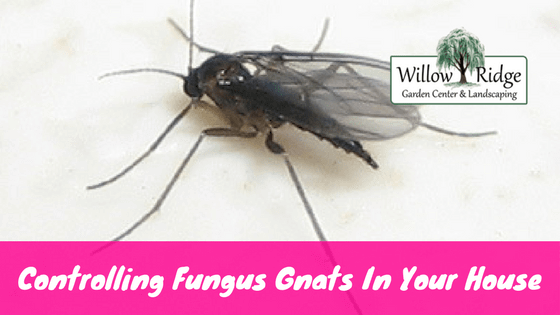Temperatures are quickly dropping and it’s time to bring our houseplants inside for the winter. Plants offer coziness and serenity to our indoor spaces but, they can also carry unwanted hitchhikers from the outdoors! The ultimate squatters who will settle in and make our lives miserable over the winter months. They will hover over our food, land in our drinks and cause us to swat at the air in a vogue like dance that would make Madonna proud. Yes, I’m talking about the dreaded Fungus Gnat!
It’s easy to mistake a fruit fly for a fungus gnat so let’s get a better look at our opponent. Fungus Gnats, like the fruit fly are tiny, only about a sixteenth of an inch long. Their bodies and wings are long like a very tiny mosquito. They spend much of their time on the surface of moist soil where they lay their eggs. Once the larva emerge, they burrow below the soil to feed on the tiny roots of your plants. Although adult gnats only live for about a week, in that time they can lay hundreds of eggs. When left unchecked, they can kill a plant from the bottom up and it’s not until lower leaves start yellowing or the plant completely stops growing that you may notice there’s a problem. Although fungus gnats are completely harmless to humans, they can be devastating to your houseplant.
The key to successfully bringing your plants indoors is elimination but ultimately, prevention. If you discover too late that you have a gnat problem, the following steps will help to eliminate them.
- Yellow Sticky Traps- Less than the size of an index card, these little traps are very effective at eliminating gnats. Cut the card into small squares and place them on top of the soil. The gnats are attracted to the color yellow and they will crawl on top of them to investigate. If the reproductive cycle has already started it may take some time to capture all of the emerging gnats but you will win the war. Fly paper can also be effective but, as we know, it can be very difficult to work with so we recommend trying the sticky traps first.
- Cider Vinegar Traps-In a shallow container such as a jar lid, pour equal parts water and cider vinegar. Stir in a few drops of Dawn dish soap and nestle the container into the soil or place it on the surface. Gnats will fly in, but they won’t fly out! Again, it will take time to capture the whole population as larvae turn into adults so be sure to refresh the mixture every few days.
If you’ve ever had to deal with a gnat problem, you quickly learn that prevention is the best medicine so here are a few tips on keeping these invaders out of your houseplants from the start.
Allow the top one inch of soil to dry out completely between waterings. Gnats are attracted to wet soil where they can lay their eggs. If soil is dry they will move on to find better conditions.
Block drainage holes. When initially potting your plants, place a coffee filter or some type of synthetic fabric at the bottom of the pot to cover the drainage hole. Water will still be able to drain but gnats won’t be able to get in. Gnats are clever and if they don’t like the moisture conditions at the top of the pot they will seek entry at the bottom.
Place a layer of sand on top of the soil about ¾ of an inch deep. This will prevent gnats from accessing soil however, it can make it difficult to know when your plants need water. In this case you may want to rely on a water meter to be sure you are not over or under watering.
Mosquito Dunks are a fantastic product that are used in water features and ponds to keep larvae from hatching. This beneficial bacteria leaches into the water and kills the eggs. To use this method for houseplants simply fill a gallon jug with water. Break apart a mosquito dunk and drop it in the water. Allow it to sit overnight and then remove the pieces. Use this to water your plants for the next month. Any larvae that are laid on the soil will quickly die. These dunks are reusable so don’t throw them away. Let them dry out and save them.
So before you bring those plants in for the winter, give them a close inspection. We hope our top suggestions for not only eliminating but preventing one of the most annoying little pests in the houseplant world has been helpful but, if you find yourself struggling don’t hesitate to reach out to us for additional support.

